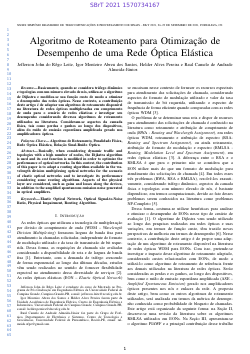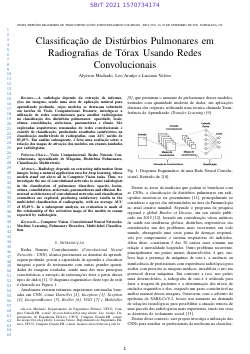
XXXIX Simpósio Brasileiro de Telecomunicações e Processamento de Sinais

Aplicação do algoritmo MSCL com subparticionamento por múltiplas rotas
Clayton J. N Lira, Raul C. Almeida Jr, Daniel Chaves
DOI: 10.14209/sbrt.2021.1570734154
Keywords: Split Spectrum Roteamento Alocação de espectro
Abstract
Due to its ability to provide resources adapted according to demand, Elastic Optical Networks have emerged as a very promising network option. Such networks have been the subject of several studies in order to present techniques and heuristics with the ability to explore their benefits and also find solutions to their problems, among them the routing and spectrum assignment. This work addresses the use of the Split Spectrum (SS) technique applied in the routing process, analyzing its performance in different scenarios and combining with the MSCL spectrum assignment algorithm. It is shown that, combining different forms of spectrum division with the spectrum allocation that generates the least loss of capacity, one can find a technique that provides better results when compared to the traditional allocation of spectrum and its classic form of division.Download

An Algorithm for Finding an Approximate Reliability Sequence for Polar Codes on the BEC
Saeid Ghasemi, Bartolomeu F. Uchôa-Filho
DOI: 10.14209/sbrt.2021.1570734156
Keywords: Polar codes reliability sequence binary erasure channel
Abstract
One of the most important parts of encoding and decoding in polar codes is finding the bit-channel reliability sequence, i.e., the positions of frozen bits and data bits, which has a great effect on the error correction performance. In this paper, we present an algorithm with linear complexity for determining an approximate reliability sequence in small disagreement with the true reliability sequence on the binary erasure channel (BEC).Download

Joint Beamforming Design for IRS-Assisted Beyond 5G Wireless Networks
Yuri Sales Ribeiro, Francisco Hugo Costa Neto, André de Almeida, Paulo R. B. Gomes
DOI: 10.14209/sbrt.2021.1570734157
Keywords: Intelligent reflecting surface beamforming spectral efficiency energy efficiency
Abstract
Intelligent reflecting surface (IRS) has emerged as a promising technology to enhance wireless communications by smartly shaping the radio propagation environment with reduced hardware and energy costs. In this paper, we integrate the IRS to a multiple-input single-output (MISO) fifth generation (5G) system via the joint optimization of the IRS reflecting coefficients and the transmit beamforming at the base station (BS) to maximize the spectral efficiency in an urban micro (UMi) propagation environment. Simulation results indicate that IRS successfully enhances the performance of the wireless network in terms of spectral and energy efficiencies compared with traditional transmit beamforming and relay-assisted systems.Download

On the Secrecy Performance of a Hybrid RF/VLC System
Isabella W. G. da Silva, Diana Pamela Moya Osorio, Edgar Eduardo Benitez Olivo, Iqrar Ahmed, Marcos Katz
DOI: 10.14209/sbrt.2021.1570734160
Keywords: Hybrid RF/VLC physical layer security secrecy outage probability Visible light communications
Abstract
This paper evaluates the secrecy outage probability of a hybrid radio frequency (RF) and visible light communication (VLC) network in the presence of an eavesdropper. We assume that data is transmitted over the RF and VLC links following a proposed multiplexing scheme in which the data sent by the source is split with a certain allocation ratio. Furthermore, the legitimate and eavesdropper users are assumed to have multihoming capabilities, so that they are able to receive data from both RF and VLC access points, simultaneously. We derive integral-form exact expression, as well as a closed-form asymptotic expression for the secrecy outage probability and validate them via Monte Carlo simulations. Our results show that multiplexing the information signal by both links leads to an enhancement of the secrecy performance since it opportunistically takes advantages of the best characteristics of both domains.Download

Algoritmo de Roteamento para Otimização de Desempenho de uma Rede Óptica Elástica
Jefferson Leite, Igor dos Santos, Helder A. Pereira, Raul C. Almeida Jr
DOI: 10.14209/sbrt.2021.1570734167
Keywords: Algoritmo de Roteamento Penalidade Física Rede Óptica Elástica Relação Sinal-Ruído Óptica
Abstract
Basically, when considering dynamic traffic and topologies with a high number of nodes, the Dijkstra algorithm is used and its cost function is modified in order to optimize the performance of optical networks. In this context, the contribution of this paper is to adapt a routing algorithm available in the wavelength division multiplexing optical networks for the scenario of elastic optical networks and to investigate its performance considering some routing algorithms. Aspects of the physical layer are considered, such as gains and losses along the devices, in addition to the amplified spontaneous emission noise generated in optical amplifiers.Download

Channel Estimation and Joint Beamforming Design for Multi-IRS MIMO systems
Kenneth Brenner Benício, Bruno Sokal, André de Almeida
DOI: 10.14209/sbrt.2021.1570734169
Keywords: Intelligent reflecting surface MIMO systems channel estimation beamforming design
Abstract
In this paper, we propose a channel estimation and joint beamforming design method for multi-IRS multiple-input and multiple-output (MIMO) systems. We investigate the scenario where multiple intelligent reflecting surfaces (IRSs) are located on the exact spot of the channel scatterers. We investigate the spectral efficiency (SE), benefits and drawbacks of deploying multiple IRSs in comparison with a scenario with a single or no IRS. Our simulation results show a trade-off between the number of reflecting elements and the total number of IRSs in the system.Download

Classificação de Distúrbios Pulmonares em Radiografias de Tórax Usando Redes Convolucionais
Alysson Machado, Leo Araújo, Luciana Veloso
DOI: 10.14209/sbrt.2021.1570734174
Keywords: Classificação Multirrótulo Redes Neurais Convolucionais Distúrbios Pulmonares Visão Computacional
Abstract
A radiologia depende da extração de informações em imagens, sendo uma área de aplicação natural para aprendizado profundo, cujos modelos se destacam sobretudo em tarefas de Visão Computacional. Destarte, investiga-se a utilização de redes convolucionais para auxiliar radiologistas no diagnóstico dos distúrbios pulmonares: atelectasia, derrame pleural, pneumotórax, consolidação, edema, lesão e opacidade pulmonar. São exploradas arquiteturas renomadas de redes convolucionais e comitês de classificação, produzindo bons resultados na classificação multirrótulo de radiografias, com acurácia de 79,54%. Em análise subsequente, os mapas de ativação dos modelos correlacionaram positivamente com anotações realizadas por radiologistas em exames de uma base de dados independente.Download

Provisionamento Multicaminho com Otimização de Particionamento de Taxa de Transmissão para Proteção Dedicada em Redes Ópticas Elásticas
Henrique A. Dinarte, Daniel Chaves, Raul C. Almeida Jr, Karcius Assis, Helio Waldman
DOI: 10.14209/sbrt.2021.1570734178
Keywords: proteção multicaminho algoritmo genético proteção dedicada com banda espremida redes ópticas elásticas
Abstract
Among the multipath protection schemes found in the literature, the Partitioning Dedicated Path Protection - PDPP proposes to divide the total transmission rate required by the connection in equal parts and then, proceed the transmission of each part using multiple disjoint paths. Nevertheless, it is also possible to partition the transmission rate unequally between paths, enabling benefits to network performance. This article proposes a meta-heuristic based on genetic algorithms to find an optmized partitioning of connections transmission rate among multiple disjoint paths, in order to provide dedicated protection and reduction in the blocking probability and average bandwidth squeezing.Download

Algoritmo Rápido para Cálculo de Centroide de Imagem com Sensores Digitais de Sol do tipo CMOS para aplicação em Pequenos Satélites
Diego Coutinho, Fernando Ramborger, Antonio Alves Ferreira Jr., Evandro Cesar Vilas Boas
DOI: 10.14209/sbrt.2021.1570734179
Keywords: algoritmo centroide de imagem CMOS sensor digital de Sol
Abstract
This work presents a fast image centroiding algorithm for CMOS-based digital sun sensors. The image is interpreted as a pixel matrix. The rows and columns pixels intensities are summed and stored in vectors. The centroid coordinates (xc, yc) are obtained by checking the row and column vector index-related higher pixel intensity. This approach was compared to the basic centroiding and thresholding method with a time processing reduction of 58% and similar precision.Download

Detecção de Atividade e Estimação de Canal em Acesso Múltiplo Uplink Grant-Free Usando o Algoritmo BOMP
Ana L Scharf, Bartolomeu F. Uchôa-Filho, Didier Le Ruyet
DOI: 10.14209/sbrt.2021.1570734185
Keywords: mMTC grant-free detecção de atividade de usuários estimação de canal
Abstract
Neste trabalho, consideramos o cenário massive Machine-Type Communication (mMTC) baseado no acesso múltiplo Grant-free no qual uma pequena parcela de um número maciço de usuários transmite pequenas quantidades de dados esporadicamente, sem requisitar permissão. O problema de detecção (esparsa) de atividade de usuários (DAU) pode ser resolvido com algoritmos de sensoriamento compressivo (CS), como FOCal Underdetermined System Solver (FOCUSS) e Orthogonal Matching Pursuit (OMP), que foram usados na literatura em canais com desvanecimento plano. Neste trabalho, a partir de um modelo de esparsidade em bloco e fazendo uso de uma aproximação polinomial para a resposta do canal, propomos o uso do algoritmo Block OMP (BOMP) para realizar DAU e estimação do canal (EC) de forma conjunta em canais com desvanecimento seletivo em frequência. Resultados de simulação mostram um excelente desempenho do algoritmo proposto.Download